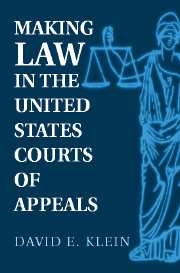Book contents
- Frontmatter
- Contents
- List of Tables
- Acknowledgments
- 1 Law Making in a Hierarchical Judicial System
- 2 Theory and Hypotheses
- 3 The Cases
- 4 Influences on Circuit Judges' Responses: Case Evidence
- 5 Influences on Circuit Judges' Responses: Interview Evidence
- 6 Anticipating the Supreme Court
- 7 Implications and Future Directions
- Appendixes
- References
- Index
7 - Implications and Future Directions
Published online by Cambridge University Press: 10 December 2009
- Frontmatter
- Contents
- List of Tables
- Acknowledgments
- 1 Law Making in a Hierarchical Judicial System
- 2 Theory and Hypotheses
- 3 The Cases
- 4 Influences on Circuit Judges' Responses: Case Evidence
- 5 Influences on Circuit Judges' Responses: Interview Evidence
- 6 Anticipating the Supreme Court
- 7 Implications and Future Directions
- Appendixes
- References
- Index
Summary
This book began with a story of law making in the courts of appeals, depicting the creation of and reaction to a new legal rule in the area of search and seizure. The final chapter begins the same way, but this story is very different from the first.
In 1984, the Seventh Circuit was called on to decide whether judges have the power to authorize video surveillance of private buildings. The question was examined with care and at great length in the court's opinion; the discussion runs to more than 150 lines in LEXIS. The three judges on the panel all agreed that judges do possess the power. Over the next ten years, another six cases in five circuits raised the question. In all six cases, the Seventh Circuit's rule was adopted.
One feature distinguishing this story from the earlier one is the unanimity in the circuits. Another is the absence of the Supreme Court. But the biggest difference is in our ability to uncover hidden elements of the story. The intervening chapters have been devoted to exploring factors that could influence judges' behavior. We are now in a better position to say which of these factors offer more or less plausible explanations for the observed actions. To illustrate this, I will briefly discuss several possible accounts of the electronic surveillance decisions, along the way considering how details from the cases reflect on them.
One credible explanation is that the judges, as conservatives, preferred a conservative rule – one favoring the state over criminal defendants.
- Type
- Chapter
- Information
- Making Law in the United States Courts of Appeals , pp. 131 - 146Publisher: Cambridge University PressPrint publication year: 2002



